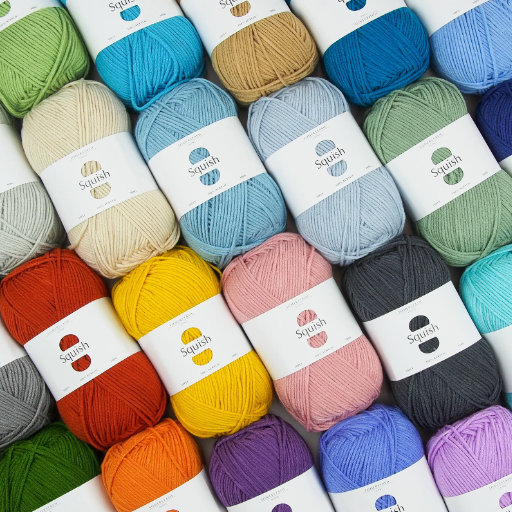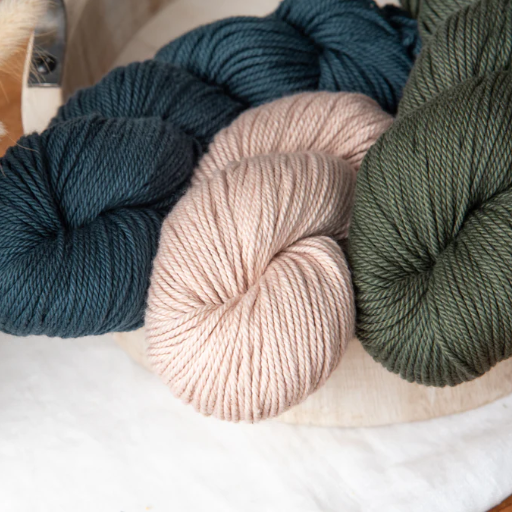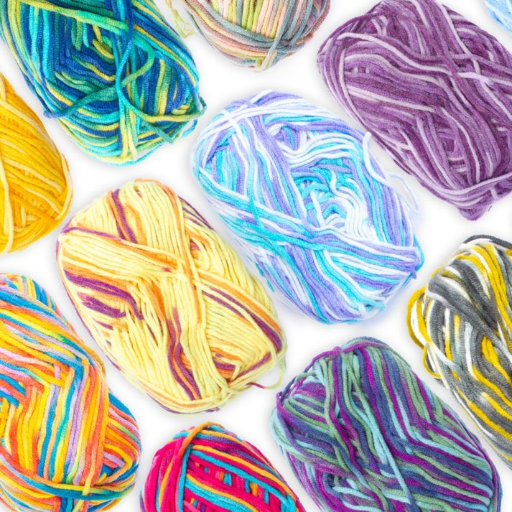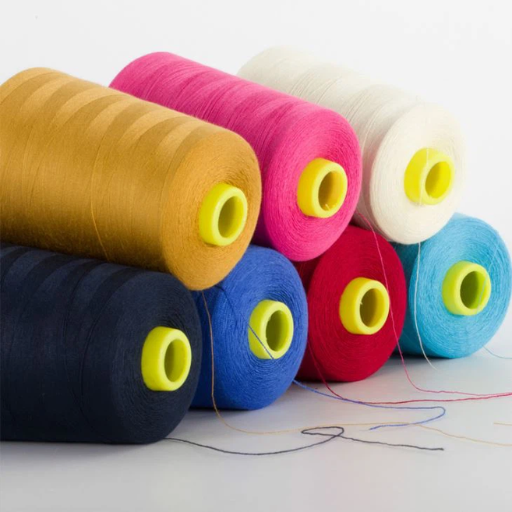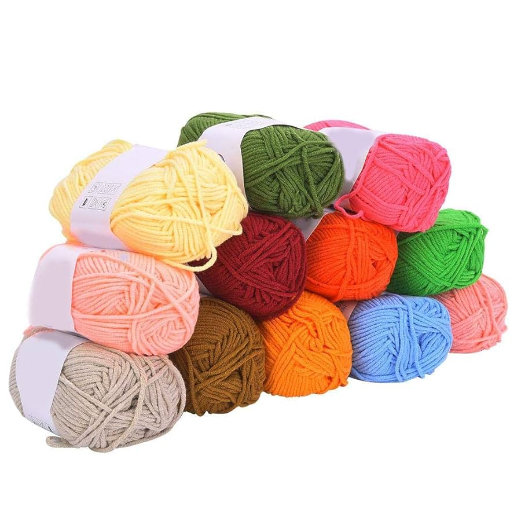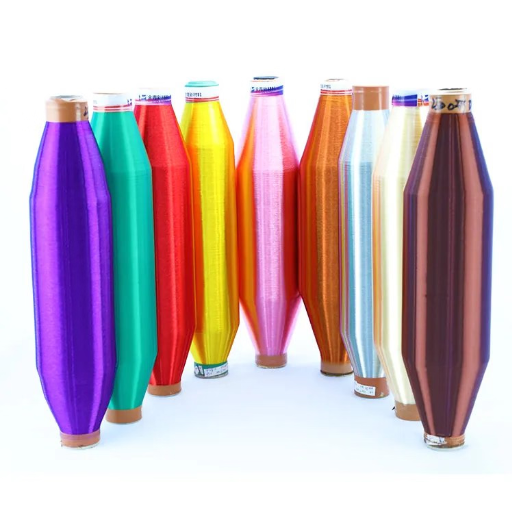Usable yarn can make or break a crocheter for it determines the quality of the project regarding texture, durability, and overall usefulness. Between all these options, acrylic and cotton yarn remain two of the most common and there is a good reason why; both these types provide different yet useful traits. In this article, we will focus on the differences between acrylic and cotton yarn regarding fiber composition, durability, cost-effectiveness, and ideal uses. Keeping this in mind, whether it is a summer project of lightweight clothes or winter accessories, knowing the details of these will allow opting for the right accentuation that gives the intended purpose and visual appeal.
What Are the Key Differences Between Acrylic and Cotton Yarn?

Voice Composition
Synthetic fibers like acrylic yarn are created with polyacrylonitrile and other polymers, which are designed to replicate the softness and stretch of natural fibers. Conversely, cotton yarn is a natural fiber from the cotton plant that is breathable, light, and environmentally friendly as well. These two aspects significantly affect their performance features and applicability on particular projects.
Performance
Acrylic yarn is very durable, does not retain moisture, and stands up well against ordinary usage over the years. It also has a low tendency to get stretched or shrunk. The same thing goes for cotton yarn which is durable too, but, unlike acrylic, it is prone to fading, absorbing a lot of heat, and getting stretched once waterlogged.
Bird Eye View
Acrylic yarn is easily regarded as cost-effective, thus making it available to beginners, or for projects. This is because synthetic fiber and mass production reduces its cost. Depending on the amount of processing done, the quality of cotton yarn determines its price as a natural fiber.
Best Uses of These Yarns
Acrylic yarn is perfect for objects that need bright colors, durability, and warmth, including blankets, winter clothes, and craft decorations. Cotton yarn is best suited for delicate garments like summer clothes, dishcloths, or lightweight baby apparel because it has a very soft feel that is gentle to the skin.
How Is Cotton Yarn Made?
Cotton yarn manufacturing begins with harvesting which involves gathering raw cotton from plants. The cotton fiber is cleaned and separated using a technique known as ginning. The ginned cotton is then carded to remove impurities and align the fibers into a consistent web. Following carding is the combing process which improves the quality of the yarn produced by removing uneven stables. After the fiber preparation, the carded fiber is spun into yarn using automated spinning machines that twist and turn them into the desired thickness and strength. The last step involves dyeing or any other finish to improve the appearance and practicality of the yarn for its intended purpose.
What Makes Acrylic Yarn a Popular Choice?
Acrylic yarn is a well-preferred material because of its cost efficiency, lifespan, and adaptability. Its weight is low, yet strong and durable due to the petroleum-based synthetic fibers that make it. The most significant benefit is that it replicates the appearance and texture of natural fibers like wool for far less. It is also machine-washable, and resistant to fading, and shrinking, which makes it excellent for low-maintenance care, such as in blankets, scarves, and other wearables. In addition, acrylic yarn is available in a broad range of colors, textures, and weights to suit every crafting need. Its moisture and mildew-resistant properties also make it invaluable for long-lasting use under difficult conditions.
How Do Acrylic vs Cotton Yarn Compare in Terms of Texture?
The texture of acrylic yarn is generally smoother and more uniform due to its synthetic nature, whereas cotton yarn offers a softer, more natural feel derived from its organic fibers. While acrylic yarn sometimes feels slightly less breathable and can have a plasticky quality, advancements have made many varieties closely mimic the texture of natural fibers like wool. Cotton yarn, on the other hand, is naturally soft, lightweight, and highly breathable, making it an excellent option for projects requiring comfort and a gentle touch. However, cotton has less elasticity compared to acrylic, resulting in a firmer texture that can lack stretch. These differences make acrylic yarn better suited for structured, durable projects, while cotton is ideal for items requiring softness and comfort, such as baby apparel or lightweight blankets.
Which Yarn Is Better for Your Crochet Project?

Picking the right yarn for a crochet project is to fulfill the requirements of your design. For example, acrylic yarn is well-suited for durable and affordable structures like toys, bags, or home decorations as it provides great shape retention. Cotton, on the other hand, is softer, more breathable, and comfortable which makes it ideal for clothing, summer accessories, and even dishcloths. Based on the texture, elasticity, care, and intended outcome of the project, you can determine the most suitable yarn.
When to Use Cotton Yarn for Crochet?
Projects that require sturdiness, breathability, and moisture absorbance are best built with cotton yarn. Garments, light scarves, and other warmer-weather accessories can be crafted easily using cotton yarn. Furthermore, its shape-holding properties make it suitable for crafting dishcloths, washcloths, and market bags. The durability and structure-holding attributes of cotton yarn make it perfect for baby accessories and home decor that require frequent washing. Although cotton yarn does not have the elasticity that synthetic fibers do, the comfort and softness of the material allow for high-quality results in intricate designs.
Why Choose Acrylic Yarn for Your Projects?
Acrylic yarn is a versatile and economical choice for a variety of crochet projects. Its affordability makes it an excellent option for beginners and large-scale designs. Acrylic fibers are lightweight, easy to care for, and highly durable, ensuring that finished items retain their shape and withstand frequent use. This yarn is also available in a vast range of vibrant colors and textures, allowing crafters to achieve diverse creative effects. Furthermore, acrylic yarn is machine-washable and quick-drying, making it practical for everyday items like blankets, scarves, and hats. While it is less breathable than natural fibers such as cotton or wool, its warmth and affordability make it an ideal choice for projects suited to cooler climates or decorative applications.
How to Decide Between Cotton or Acrylic for Specific Projects?
Choosing between cotton and acrylic yarn depends on the details of your specific project. Best for absorbent and lightweight garments like summer clothing, dishcloths, or infant apparel, cotton yarn possesses great breathability and durability. Its natural fibers are hypoallergenic which makes it better for softer warm weather items. On the downside, cotton is heavier in comparison to acrylic and lacks elasticity.
Acrylic yarn is best for children’s clothing due to its warmth, vibrant colors, elasticity, affordable price, and lightweight. Cotton offers better strength for intricate patterns and precise stitch works, while acrylic excels in enabling better stretch and recovery. Moreover, its firm structure makes it the best for projects requiring stronger stitch definitions. Lastly, cotton cotton also makes a superior choice for projects that need deep stitches.
Ultimately, consider the bar use, local climate, and texture requirements of your project when selecting between these two materials. Blending acrylic and cotton can provide the best of both worlds for greater adaptability.
How Do Cotton and Acrylic Yarns Differ in Durability?

Due to the natural fibers making up its composition, cotton yarn is almost always stronger than acrylic since it has a higher resistance to wear and tear over time. This kind of toughness means it is ideal for things that are used regularly or need frequent washing like bags or dish rags. On the other hand, acrylic yarn is more lightweight and less resistant to abrasion which means it is subject to pilling over time, especially with constant friction. Regardless of that, acrylic is comparatively more elastic and resistant to stretching than cotton. In conclusion, the specific requirements of the product’s purpose and construction determine the durability of each yarn.
Is Cotton Yarn More Durable Than Acrylic?
Cotton yarn is superior to acrylic for wharves and cotton because of the lower scope of wear and tear. Wharves and cottons feature greater tensile strength and durability due to their natural fiber structure. This makes it great for household uses such as dishcloths, towels, and bags which need constant washing. On the other hand, although acrylic yarn is not as durable because it is prone to pilling and abrasion due to friction, It also has much better elasticity and resistance to being stretched. The final choice remains on the purpose of the item to be used with cotton being ideal for strength and acrylic being ideal for flexibility and lower price.
Can Acrylic Yarn Withstand Frequent Washing?
Acrylic yarn is highly resistant to damage caused by repeated washing due to its synthetic fiber composition. Unlike natural fibers, acrylic does not shrink, warp, or lose its structure easily when exposed to water and detergents. It retains its color vibrancy and shape over time, making it suitable for projects such as blankets, garments, and other everyday items that require frequent laundering. However, it is prone to pilling and may lose its smooth texture with excessive friction during washing. To prolong its lifespan, it is recommended to use gentle cycles and avoid high heat during drying.
What Are the Environmental Impacts of Cotton vs Acrylic?

The production processes of cotton and acrylic result in the fibers having varying environmental effects. Cotton is a natural fiber, but its agriculture is often resource intensive, requiring massive amounts of water, fertilizers, and pesticides which contributes to soil erosion as well as water pollution. On the other hand, acrylic is composed of fibers that are synthesized from chemicals derived from petroleum, which means it is non-renewable and its production requires great amounts of energy. Furthermore, acrylic is also nonbiodegradable, making the waste management concerns more severe. Cotton farming is aimed at the end of the farming cycle, where the resource-intensive practices employed can be challenged due to the biodegradability of the end product. Cotton farming is sustainable in the end, unlike acrylic farming which is nonsustainable in the long run. Ultimately, the decision lies in whether to prioritize sustainability during non-use or post-use consequences.
Is Cotton Yarn More Sustainable?
To establish whether cotton yarn is more sustainable than other types of yarn, one has to assess its environmental consequences at every stage of its life cycle. Cotton is a natural fiber that has the advantage of biodegradability whereas its cultivation is highly resource-thirsty, using water—in some regions, as much as up to 20,000 liters per kilogram of fiber—and vast amounts of fertilizers and pesticides. Cotton farming, if not done responsibly, is liable to soil erosion, water contamination, and loss of species.
Acrylic yarn, on the contrary, is produced from synthetic petrochemical fibers and does not engage agriculture but its sustainability has its issues. Its creation is also energy laborious and the raw material is nonbiodegradable which means that it will remain in dumpsites for a long period. In addition, fabrics made from acrylic fibers tend to shed microplastics when washed, so the precursors contribute further to environmental problems.
Between the two options, cotton yarn is more sustainable in biodegradability at the end of its life cycle. Still, the substantial fossil fuel costs need to be deliberated upon. The impacts can be lessened through sustainable cotton initiatives, for example, organic cotton farming or efficient irrigation systems. On the other hand, acrylic’s lessened agricultural production and its durability make it suitable, although it poses great dangers to the environment in the long run. In the end, it comes down to what one deems more important and what approach is taken: sustainability in resource utilization during the production stage or the detrimental effects after disposal.
Does Acrylic Yarn Have a Larger Environmental Footprint?
In the argument of archaic yarn vs cotton yarn, acrylic usually has a higher environmental impact compared to cotton because it uses petroleum-based polyester fibers as its raw materials. The greenhouse gas emissions from the use stage Le were high. Additionally, the production phase in which acrylic yarn is created will require a great deal of energy which will need the use of fossil fuels repeatedly. Furthermore, the fibers will emit microplastics which pose a great threat to marine organisms. On the other hand, cotton yarn has problems with the use of water and pesticides during farming which are very challenging. However, farmers can reduce these problems due to organic farming and the usage of drip irrigation. In the end, acrylic non-biodegradability throughout its life cycle and microplastic pollution alongside their fossil fuel usage make it seem they have far more harmful footprints in comparison to sustainably produced organic cotton.
How to Choose the Right Yarn for Your Crochet or Knit Projects?

When selecting a yarn for any knit or crochet project, think about how the yarn will be used, its strength, and the sustainability of the product. For soft and breathable items like baby’s clothing and summer wear, cotton yarn is great, especially when organic sustainably sourced cotton is available. But, for projects that require stretch or warmth like winter clothing, acrylic yarn may be best even with its environmental costs. The gauge and weight must also fit the pattern, and how the garment is laundered must fit into your lifestyle. Ultimately, the balance between the project’s requirements and the constraints of personal and environmental issues will…be considered the best selection of yarn.
Factors to Consider When Choosing the Right Yarn
- Fiber Content
The type of fiber in the yarn influences the texture, stretch, breathability, and durability of your project. Natural fibers like cotton and wool are great for comfort and sustainability, while synthetic fibers such as acrylic provide elasticity and affordability. Blended yarns combine attributes of different fibers to their advantage.
- Yarn Weight
Yarn weight dictates the thickness of the yarn and is crucial to matching the pattern’s requirements. Common weights range from lace to super bulky. Selecting the right weight ensures the finished project has the appropriate density and drape.
- Gauge Compatibility
Ensuring that the yarn is compatible with the gauge indicated in your pattern is essential. Gauge affects the size, fit, and overall look of the final product. Always perform a swatch test to ensure accuracy.
- Texture and Appearance
Yarns come in smooth, textured, or novelty varieties. Consider the desired aesthetic of the project. Smooth yarns allow detailed patterns to stand out, while textured yarns add visual dimension.
- Care and Maintenance
Determine whether the yarn requires hand washing or is machine washable. Some projects, like baby clothing or blankets, may benefit from easy-care options.
- Environmental Impact
For a sustainable choice, prioritize organic and eco-friendly yarns over synthetic options. Look for certifications such as GOTS (Global Organic Textile Standard) to ensure ethical production.
These factors collectively determine the success and suitability of your crochet or knitting projects. Evaluate each element thoroughly to achieve a balance between practicality and creativity.
How Does the Type of Yarn Affect Your Finished Product?
Yarn selection plays an important role in the outcome of your project in many crucial ways. Firstly, the fiber content gives texture, stretch, and strength to the product. For instance, wool has good warmth and stretch, but it is also somewhat thick. Furthermore, cotton has good structure and breathability. Secondly, the weight of the yarn determines how the garment will drape and gauge which is important for the fit and overall appearance of the clothing or accessory. Lastly, the ply and finish of the yarn determine how the stitches are defined and how attractive the fabric is—tight ohs, uh smooth, lines enhance more detailed stitches, while, rough, fluffy, or textured, yarns, create softer stitched looks. Selecting the right yarn type lets you achieve your defined, specific, and detailed requirements in your project in a polished way.
References
Frequently Asked Questions (FAQ)
Q: What are the main differences between acrylic yarn and cotton yarn for crochet projects?
A: When comparing acrylic yarn vs cotton yarn, the main differences lie in their composition and feel. Acrylic yarn is a synthetic fiber, known for its durability and wide range of colors. It is often warmer and slightly stretchy. Cotton yarn, on the other hand, is a natural fiber, made from the fibers of the cotton plant, and is known for its breathability and softness.
Q: Is acrylic yarn better than cotton yarn for blankets?
A: It depends on the desired qualities of the blanket. Acrylic yarn is often chosen for its warmth, durability, and ease of care, making it a good choice for cozy, long-lasting blankets. Cotton yarn is preferred for lightweight, breathable blankets that are ideal for warmer climates or for people who prefer natural fibers.
Q: What are the pros and cons of using acrylic yarn for crochet projects?
A: Acrylic yarn is often praised for its affordability, durability, and variety of colors. It is easy to care for and machine washable. However, it may not be as breathable as natural fibers and can sometimes feel less soft than cotton or wool yarn.
Q: Can I use acrylic yarn for all types of crochet projects?
A: Yes, you can use acrylic yarn for a wide variety of crochet projects, from garments to home decor. Its versatility and ease of use make it a popular choice for both beginners and experienced crafters. However, consider the project’s specific needs, such as breathability or warmth, when choosing a yarn type.
Q: How does polyester yarn compare to acrylic yarn for knitting and crocheting?
A: Polyester yarn, like acrylic yarn, is a synthetic fiber and shares similar properties such as durability and a wide range of colors. However, polyester is often smoother and more lustrous, which can affect the texture and appearance of the finished project. Both are highly versatile, but the choice depends on the desired finish and feel.
Q: What makes cotton yarn a good choice for summer crochet projects?
A: Cotton yarn is a natural fiber that is breathable and absorbs moisture, making it ideal for summer projects. It is comfortable to wear in warm weather and is often chosen for making lightweight garments, accessories, and home decor items.
Q: How does the care and maintenance differ between cotton and acrylic yarn?
A: Acrylic yarn is low-maintenance, often machine washable, and can be tumble-dried without much risk of shrinking or losing shape. Cotton yarn, being a natural fiber, may require more careful washing to prevent shrinkage, and it may take longer to dry. Always check the care instructions on the yarn label.
Q: Is it possible to blend cotton and acrylic yarn in a single crochet project?
A: Yes, blending cotton and acrylic yarn in a single project can combine the best properties of both fibers. Cotton blend yarns offer breathability and softness while maintaining the durability and ease of care associated with acrylic. This combination is great for projects needing both qualities.








